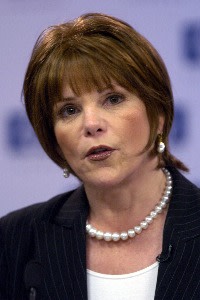Women continue to lead the way in the ETF industry

Roula Khalaf, Editor of the FT, selects her favourite stories in this weekly newsletter.
There were many opportunities for women to make their mark in exchange traded funds in the early days, recalls Joanne Hill, who was lead ETF analyst at Goldman Sachs in the 1990s — and later co-founded Women in ETFs. “To me, the ETF industry was started by a woman,” she says.
Hill is referring to the late Patricia Dunn, who was chief executive of Barclays Global Investors from 1995 to 2002. Although it was rival firm State Street that launched the first ever ETF in 1993, with the ticker symbol SPDR, the firm did not maximise its first-mover advantage, she argues. It was Dunn who persuaded her board at BGI to launch in a full suite of ETFs.

Thus, in 2000, the iShares ETF brand was born. And today, under BlackRock’s ownership, it is the world’s leading ETF business, by assets under management.
“Men raise their hands and work in places that are already high profile and have large revenues,” observes fellow Women in ETFs co-founder Deborah Fuhr, who runs ETFGI, a research business. “Women are more inclined to raise their hand and get involved with something that’s new and developing.”
In 2014, Hill and Fuhr — who also joined the industry in the nineties — were among five professionals who launched Women in ETFs, adopting the tagline “connect, support, inspire” to help women make strides in the industry. Their other co-founders were Sue Thompson, Michelle Mikos and Linda Zhang, who held senior positions at BlackRock, Invesco PowerShares and a financial advice firm, respectively.
Now celebrating its 10th year, the organisation has been described as a de facto professional network for ETF professionals and includes more than 10,000 members globally. Men are a welcome and growing part of that membership.
High profile women in the industry were involved from the outset. The organisation’s charter was crafted by Kathleen Moriarty, the lawyer who got SPDR through the Securities and Exchange Commission’s challenging approval process — landing her the nickname Spider Woman.
Early board members included Valérie Baudson, now chief executive officer of Amundi, and Rachel Lord, then head of iShares for Emea and now head of international at BlackRock.

Many senior women knew each other from the conference circuit and “wanted to share their networks and success with others”, explains Mikos, managing director for ETF due diligence at Invesco.
She says the ETF industry was ripe for a professional network due to the multiple players involved, including asset managers, broker-dealers, index providers and exchanges.
There was a “volcanic eruption of interest” and attracting members was never a challenge, Mikos remembers.
Growth in the network’s members and sponsors — the latter of which now total 50, including BlackRock, State Street and Vanguard — has paralleled the growth in ETF assets, says its US co-president Emily Meyer, who is a vice-president at Northern Trust Asset Management. Morningstar data shows global ETF assets under management have grown more than fivefold since the start of 2014, from $2.2tn to $11.6tn today.
The finance industry has also become more focused on diversity over the period, albeit with some recent backlash in the US, notes Fuhr. There are even ETFs that specifically track companies with gender diverse leaders and workplaces. Together, they hold with $1.3bn of assets, according to Morningstar, and the vast majority were launched over the past decade.
Women in ETFs is drawing in members in nascent markets, too. South Africa is the third-largest chapter in the Emea region, behind the UK and Ireland — despite the country’s investment platforms being biased towards unit trusts, says chapter co-head Michelle Noth.
Leadership opportunities are plentiful with 29 chapters in total and co-heads working on a two-year rotation in each of the four regions — including identical twins in Canada.
“It seems like they’re always trying to create more opportunities for folks at various levels, not just waiting for them to have the big job,” says former State Street ETF boss Jim Ross.
Spain, Poland and South Korea are among the newest chapters while, in the US, the Pacific Northwest chapter recently launched — the first to be co-headed by a man, Ramiro Higuera.
Looking to the next 10 years, Meyer’s ambition is to reach 20,000 Women in ETFs members and create the first chapter in South America. China, Malaysia and Thailand chapters are already in the pipeline, according to Asia Pacific co-president Rebecca Sin.
But the frankest account of why a women’s membership group was needed in the ETF industry — and why it helps to have men in the room — comes from Ross, an industry veteran who was behind the SPDR launch.
“When I was in charge, we just recruited male college athletes,” he says. “I didn’t even think about diversity, we were just growing quickly and it wasn’t front of mind.” Women in ETFs enabled him to put himself in his female colleagues’ shoes. “I went to a breakfast event full of women and I was in the minority. I thought this is what they feel like when they go to a sales luncheon or breakfast or dinner,” he explains.
Diversity is something Ross wishes he understood earlier in his career as he “probably would have built a better organisation”.
It was not until three years before his retirement that State Street unveiled the Fearless Girl statue in 2017 — an attempt to draw attention to its gender diversity ETF but also something that become a symbol of ‘girl power’.

Fuhr says awareness around diversity is growing across financial services, but men have become “much more involved” as the ETF industry has matured, and dominate many leadership teams.
That makes an organisation like Women in ETFs more relevant than ever, she argues. “If anything, what we would like to do is see more diversity among other measures, so race, location, religion,” Fuhr suggests. “I think the statistics would say that the financial industry overall is still not making those types of strides it should be making.”

Comments